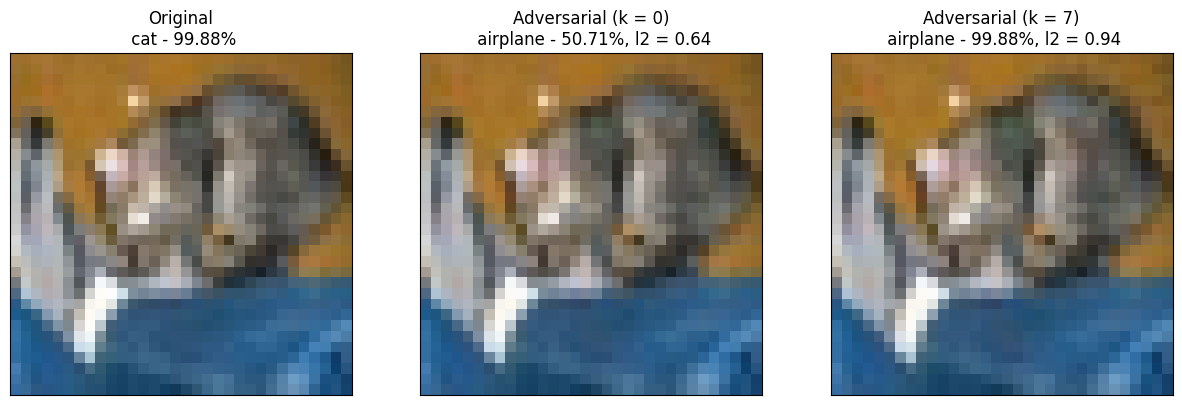はじめに
「C&W Attack」という敵対的サンプル攻撃をPyTorchで実装しました。
画像データはCIFAR10を用いました。
実装にあたり書籍「AIセキュリティから学ぶディープラーニング[技術]入門」に掲載のソースコードを参考にしました。
参考元ソースコード
実装
本稿では L2 Attack、Targeted Attack を実装します。
モジュールのインポート
import numpy as np
import torch
import torch.nn as nn
import torch.nn.functional as F
import torchvision
import torchvision.models as models
import torchvision.transforms as transforms
import matplotlib.pyplot as plt
データの用意
mu=0.5
sigma=0.5
transform = transforms.Compose([
transforms.ToTensor(),
transforms.Normalize((mu, mu, mu), (sigma, sigma, sigma)),
])
trainset = torchvision.datasets.CIFAR10(
root='./data',
train=True,
download=True,
transform=transform
)
trainloader = torch.utils.data.DataLoader(
trainset,
batch_size=100,
shuffle=True,
num_workers=2
)
testset = torchvision.datasets.CIFAR10(
root='./data',
train=False,
download=True,
transform=transform
)
testloader = torch.utils.data.DataLoader(
testset,
batch_size=1,
shuffle=False,
num_workers=2
)
モデルの用意
def Net():
model_ft=models.resnet50(pretrained=True)
model_ft.fc=nn.Linear(model_ft.fc.in_features, 10)
return model_ft
# Define what device we are using
use_cuda=True
device = torch.device("cuda" if (use_cuda and torch.cuda.is_available()) else "cpu")
# Initialize the network
model = Net().to(device)
# Load the pretrained model
path="./exp/bestloss.pth"
model.load_state_dict(torch.load(path))
# Set the model in evaluation mode. In this case this is for the Dropout layers
model.eval()
前準備
class2name={
0: "airplane",
1: "automobile",
2: "bird",
3: "cat",
4: "deer",
5: "dog",
6: "frog",
7: "horse",
8: "ship",
9: "truck",
}
攻撃
class CW2:
""" C&W Attack (L2) による敵対的サンプルを生成
Attributes:
classifier (Model) : logits を出力するモデル
k (float): 自信を調整するパラメータ
learning_rate (float): Adam の学習率
binary_search_steps (int): バイナリサーチの回数
max_iterations (int): Adam の最大イテレーション回数
initial_c (float): c の初期値
"""
def __init__(self, model, k = 0, learning_rate = 0.01,
binary_search_steps = 9, max_iterations = 1000,
initial_c = 0.001):
# 引数をすべてインスタンス変数にセット
self.model = model
self.k = k
self.learning_rate = learning_rate
self.max_iterations = max_iterations
self.binary_search_steps = binary_search_steps
self.initial_c = initial_c
def is_satisfied_with_k(self, logits, target_class):
"""
「 k を加味したターゲットクラスの logit が最大」という制約を満たすか確認する。
ターゲットクラスの logit から k を引いた値が他のどのクラスの logit よりも大きければ True を返し、
そうでなければ、False を返す。
Args:
logits (ndarray): logits
target_class (ndarray): ターゲットクラス
Returns:
satisfied (bool): 制約を満たす場合は True、そうでなければ False
"""
# logits = np.copy(logits)
logits[target_class] -= self.k
satisfied = torch.argmax(logits) == target_class
return satisfied
def generate(self, original_image, target_class_ohe):
"""
敵対的サンプルを生成
Args:
original_image (tensor): オリジナル画像 `(28, 28)`
target_class_ohe (tensor): ターゲットクラスの One-Hot `(10, )`
Returns:
o_best_adv_image (tensor): 敵対的サンプル `(28, 28)`
"""
# ターゲットクラスを変数にセット
target_class = np.argmax(target_class_ohe)
# オリジナル画像の型を変数にセット
shape = original_image.shape
# c とその下限値と上限値をセット
c = self.initial_c
c_lower = 0
c_upper = 1e10
# (tanh(w) + 1) / 2 の w
w = torch.zeros(shape, dtype=torch.float32)
w.requires_grad = True
# オリジナル画像を Tensor にキャスト
# original_image = torch.tensor(original_image, dtype=torch.float32)
# 目的関数を生成する
def build_objective(c, w):
# 敵対的サンプルを格納する変数
# adv_image = (torch.tanh(w) + 1) / 2
adv_image = torch.tanh(w) # 正規化後の画像は[-1,1]
# 目的関数1
objective1 = torch.sum(torch.square(adv_image - original_image))
# 敵対的サンプルの logits
logits = self.model(adv_image)[0]
# ターゲットクラスの logit
target_logit = torch.sum(target_class_ohe * logits)
# ターゲットクラス以外の logit の最大値
other_max_logit = torch.max((1 - target_class_ohe) * logits + (target_class_ohe * torch.min(logits)))
# 目的関数2
objective2 = c * torch.maximum(torch.tensor(0.0), other_max_logit - target_logit + self.k)
# 目的関数
objective = objective1 + objective2
return objective
# Adam のインスタンスを生成
opt = torch.optim.Adam([w], lr=self.learning_rate)
# 目的関数の最小化の過程で見つかった最小の objective1、敵対的サンプル、分類結果を格納する変数
o_best_objective1 = np.inf # 初期値として無限をセット
o_best_adv_image = np.zeros(shape) # 初期値としてすべての要素に0をセット
o_best_class = -1 # 初期値としてダミークラスをセット
# バイナリサーチ用のループ
for outer_step in range(self.binary_search_steps):
# print("outer_step: ", outer_step)
# バイナリサーチのステップ内で見つかった最小の objective1 と分類結果を格納する変数
best_objective1 = np.inf # 初期値として無限をセット
best_class = -1 # 初期値としてダミークラスをセット
# objective を保存しておく変数
prev_objective = np.inf # 初期値として無限をセット
# Adam を実行するループ
for iteration in range(self.max_iterations):
# print(" iteration: ", iteration)
# Adam を実行
opt.zero_grad()
objective = build_objective(c, w)
objective.backward()
opt.step()
# 敵対的サンプルの logits 取得
# adv_image = (torch.tanh(w) + 1) / 2
adv_image = torch.tanh(w) # 正規化後の画像は[-1,1]
logits = self.model(adv_image)[0]
objective1 = torch.sum(torch.square(adv_image - original_image))
# max_iterations の 10% ごとに objective を確認
if iteration % (self.max_iterations // 10) == 0:
# objective にほとんど変化がない、もしくは増えている場合は Adam のループを抜ける
if build_objective(c, w) > prev_objective * 0.9999:
break
# 次のステップの比較用に現在の objective を保存
prev_objective = build_objective(c, w)
# 制約を満たすか確認
satisfied = self.is_satisfied_with_k(logits, target_class)
# objective1 が、best_objective1 より小さく、制約も満たせば、best_objective1 と best_class を更新する
if objective1 < best_objective1 and satisfied:
best_objective1 = objective1
best_class = target_class
# objective1 が、o_best_objective1 より小さく、制約も満たせば、o_best_objective1, o_best_class, o_best_adv_image を更新する
if objective1 < o_best_objective1 and satisfied:
o_best_objective1 = objective1
o_best_class = target_class
o_best_adv_image = adv_image
# 現在のバイナリサーチのステップで制約を満たしている場合
if best_class == target_class:
# c の上限値に現在の c をセットする
c_upper = c
# c に 「現在の c」 と 「c の下限値」 の平均値をセットする
c = (c_lower + c_upper) / 2
# 見つからなかった場合
else:
# c の下限値に現在の c をセットする
c_lower = c
if c_upper < 1e9:
# c の上限値が 1e9 未満の場合は、c に 「現在の c」 と 「c の上限値」 の平均値をセットする
c = (c_lower + c_upper) / 2
else:
# それ以外は、c が大きくなりすぎないように、c を 10 倍する
c *= 10
# ログ出力
print('Binary Search {0}/{1}'.format(outer_step + 1, self.binary_search_steps))
print(' L2 square: {0:.2f} - c: {1:.2f} - class: {2}'.format(o_best_objective1, c, o_best_class))
# 敵対的サンプルを ndarray に変換して返す
return o_best_adv_image
original_image, _ = testset[0]
original_image=original_image.unsqueeze(0)
target_class_ohe = F.one_hot(torch.tensor(0), num_classes=10) # ターゲットクラスを 0 とする
k=0 の攻撃
attack = CW2(model, k=0) # k = 0 で CW2 のインスタンスを生成
adv_image_k0 = attack.generate(original_image, target_class_ohe) # 敵対的サンプルを生成
# 推論結果。 model_logits ではなく、model での推論である点に注意
Y_hat_k0 = model(adv_image_k0)
# スコア
score_k0 = torch.max(torch.softmax(Y_hat_k0, dim=1)).item()
# 分類結果
class_k0 = torch.argmax(Y_hat_k0[0]).item()
advk0_name = class2name[class_k0]
# L2
adv_img_k0 = adv_image_k0[0].detach().numpy()
orig_img = original_image[0].numpy()
L2_k0 = np.linalg.norm(adv_img_k0 - orig_img)
adv_img_k0 = mu+sigma*adv_img_k0
adv_img_k0 = adv_img_k0.transpose(1,2,0)
k=7 の攻撃
attack = CW2(model, k=7) # k = 0 で CW2 のインスタンスを生成
adv_image_k7 = attack.generate(original_image, target_class_ohe) # 敵対的サンプルを生成
# 推論結果。 model_logits ではなく、model での推論である点に注意
Y_hat_k7 = model(adv_image_k7)
# スコア
score_k7 = torch.max(torch.softmax(Y_hat_k7, dim=1)).item()
# 分類結果
class_k7 = torch.argmax(Y_hat_k7[0]).item()
advk7_name = class2name[class_k7]
# L2
adv_img_k7 = adv_image_k7[0].detach().numpy()
orig_img = original_image[0].numpy()
L2_k7 = np.linalg.norm(adv_img_k7 - orig_img)
adv_img_k7 = adv_img_k7.transpose(1,2,0)
adv_img_k7 = mu+sigma*adv_img_k7
可視化
plt.figure(figsize=(15, 15))
# オリジナル画像を表示
plt.subplot(1, 3, 1)
plt.gca().axes.xaxis.set_visible(False)
plt.gca().axes.yaxis.set_visible(False)
plt.title('Original\n {0} - {1:.2f}%'.format(class2name[original_class], original_score * 100))
plt.imshow(img)
# k = 0 の敵対的サンプルを表示
plt.subplot(1, 3, 2)
plt.gca().axes.xaxis.set_visible(False)
plt.gca().axes.yaxis.set_visible(False)
plt.title('Adversarial (k = 0)\n {0} - {1:.2f}%, l2 = {2:.2f}'.format(class2name[class_k0], score_k0 * 100, L2_k0))
plt.imshow(adv_img_k0)
# k = 7 の敵対的サンプルを表示
plt.subplot(1, 3, 3)
plt.gca().axes.xaxis.set_visible(False)
plt.gca().axes.yaxis.set_visible(False)
plt.title('Adversarial (k = 7)\n {0} - {1:.2f}%, l2 = {2:.2f}'.format(class2name[class_k7], score_k7 * 100, L2_k7))
plt.imshow(adv_img_k7)
可視化は以下のようになります。

k=0, k=7 ともに airplane と誤認識させることに成功しています。
ここでよく見ると、k=0 ではスコア(airplaneの確率)が50.71%であるのに対して、k=7 のほうがスコアは99.88%と高くなっています。(その分l2ノルムも大きくなっています)
終わりに
現論文によると C&W Attack は当時有効とされていた Distillation Defense を破った手法とのこと。
時間を見つけて防御手法も調査していきたい。